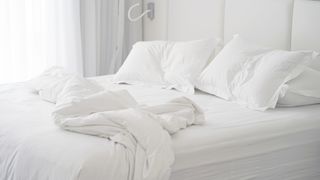According to a press release (opens in new tab), independent lab testing has certified that the products meet the CDC’s Level 4 standard to provide the highest level of barrier protection. Level 4 testing is the same resistance test standard created by the CDC for surgical gowns, and assesses the ability of a fabric to block the virus Phi-X174 Bacteriophage. So this is a big deal for Protect-A-Bed, and it’s good news for those of you looking to reduce the potential for particles, allergens, dust mites and more to infiltrate your bed. The products from the viral barrier range include a:
Cotton Premium Waterproof Mattress Protector (from $65.99) (opens in new tab)Dust Mite & Bed Bug Proof Mattress Encasement (from $74.99) (opens in new tab)Basic Waterproof Pillow Cover ($10.99) (opens in new tab)
What is a viral barrier on bedding?
Plenty of the best mattress online (opens in new tab) brands use anti-allergen and anti-bacterial coverings on their mattresses and pillows (opens in new tab), as do some of the best bed toppers (opens in new tab) brands, so what makes a viral barrier worth talking about? And what exactly is it? In this specific instance, a viral barrier is established when ‘the fabric resists viruses passing through’. The mattress and pillow protectors also feature the brand’s waterproof Miracle Membrane. According to Protect-A-Bed, the technology ‘creates an air vapor porous barrier for mattresses and pillows that blocks viruses, allergens, dust mites, bed bugs and moisture from penetrating the sleep surface.’ Some are certified as asthma and allergy friendly by the Asthma and Allergy Foundation of America (AAFA), too. Protect-A-Bed recommends using a mattress encasement first, before adding a mattress protector and protective pillow covers. “Our newest viral barrier protection should provide greater peace-of-mind that is crucial in today’s climate,” states Bob Burbank, Chief Executive Officer at Protect-A-Bed. However, Protect-A-Bed isn’t the first brand this year to pass the CDC test. CleanBrands (opens in new tab) achieved it a few months back for its protective bedding range made of a waterproof and breathable fabric called MicronOne.
How to create a healthy sleep space
Regular cleaning of your bedroom and bed will help you stay on top of allergens, bacteria and more. Learning how to clean a mattress (opens in new tab) properly is the first step in creating a healthy sleep environment. Considering how a recent study showed that beds are potential COVID-19 hotspots (opens in new tab), wiping down your bed frame, bedside table and lamp and light switches with a disinfectant is a vital hygiene measure. For this you could use an EPA-approved disinfectant (opens in new tab) such as Clorox or Lysol Disinfectant Spray. In a press release (opens in new tab), the EPA stated that, based on lab testing, the Lysol surface cleaning products were effective against the coronavirus when used according to the manufacturer’s guidelines. When it comes to washing bedding and mattress and pillow protectors, read our guide to what the coronavirus means for your laundry routine (opens in new tab). For more mattress related content, take a look at our guides to the best cooling mattress (opens in new tab), the best Purple mattress deals (opens in new tab), the best Saatva mattress discounts (opens in new tab), and the best Casper mattress deals (opens in new tab) for luxury beds for less.
